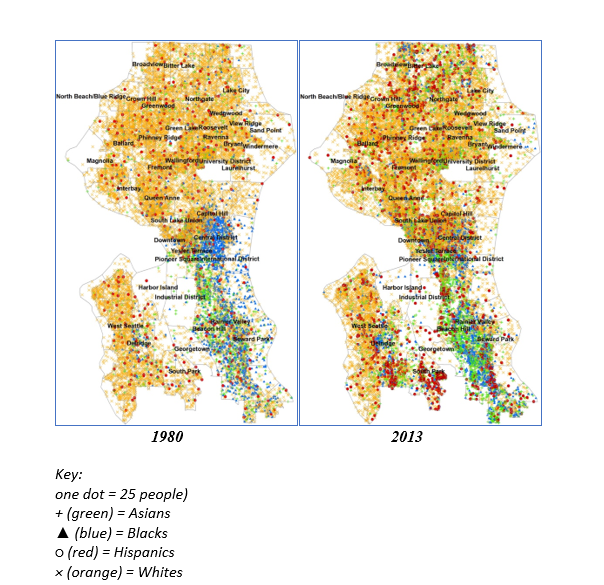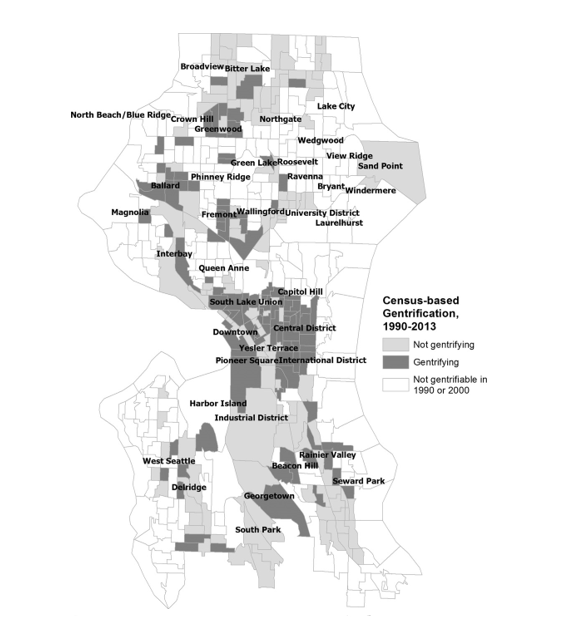Race, Immigration, and Gentrification in Seattle, 1970-2013
While gentrification has been occurring in Seattle for several decades, the racial and ethnic composition of its gentrifying areas has changed in significant ways, according a recent article in City and Community by Jackelyn Hwang, a former Meyer Doctoral Fellow who is now an Assistant Professor of Sociology at Stanford University.
In “Gentrification without Segregation? Race, Immigration, and Renewal in a Diversifying City,” which is based in part on the work she did with Center funding, Hwang uses a variety of techniques to review Seattle’s gentrification – generally defined as above average increases in housing costs and residents’ incomes or education levels in neighborhoods that previously were home to less educated, less affluent people living in lower-cost housing. She finds that in the 1970s and 1980s – when housing costs were low, Seattle wasn’t adding many new residents, and there were few immigrants – gentrification tended to occur in neighborhoods with relatively larger shares of white, non-Hispanic residents. However, in the 1990s and 2000s, as housing costs rose and immigration increased, gentrification “was more likely to take place in neighborhoods with greater shares of Blacks and less likely to take place in neighborhoods with lower shares of Asians.”
While the “the popular image of gentrification is one in which White gentrifiers establish residence in minority, particularly African American, neighborhoods,” the findings for the earlier period in Seattle are consistent with much of the existing scholarship on gentrification, which shows how gentrifiers generally avoided these neighborhoods. Even so, Hwang notes, they are notable because unlike most cities where scholars have studied gentrification, such as Chicago, Seattle was (and continues to be) “a predominantly White city with relatively low segregation levels.”
In more recent decades, Seattle, like many cities, has grown and become more diverse. Between 1980 and 2013, its population grew from just under 500,000 people to almost 625,000 people, the share of non‐Hispanic Whites declined from 78 to 67 percent, and the share of non-Hispanic Blacks fell from 9 to 7 percent. In contrast, the Asian population’s share doubled to 14 percent, while the Hispanic share more than doubled to 6 percent (Figure 1).
Figure 1: Ethnic and Racial Groups in Seattle, 1980 and 2013
Source: US Census and American Community Survey
As the overall population grew and changed, so did changes in potentially gentrifiable neighborhoods – places where median household incomes were below the citywide median household income at the start of the study period. Notably, between 1990 and 2013, a 1 percentage point increase in a potentially gentrifiable neighborhood’s share of Asian residents was associated with a 3.9 percent decrease in the odds of a neighborhood gentrifying. In contrast, a 1 percentage point increase in a gentrifiable neighborhood’s share of Black residents was associated with a 3.4 percent increase in the odds of a neighborhood gentrifying. Together, these findings suggest that “increased immigration to a city with a tight housing market may have unintended consequences on Black urban neighborhoods” (Figure 2).
Figure 2: Gentrification in Seattle, 1990-2013
Source: US Census and American Community Survey
While these patterns might be different from those found in highly segregated cities, Hwang notes they are likely similar to those found in other gentrifying cities that historically had low levels of segregation but now are becoming more racially and ethnically diverse, such as Portland, Oregon or Portland, Maine. Assuming the patterns hold, she contends the findings underscore the need for “targeted interventions to stem processes of neighborhood change exacerbating disadvantage” for Black residents. She notes that these interventions might include subsidies and legal protections from price increases and evictions, inclusionary zoning requirements, inclusive and equitable development processes, and policies and programs that address racial wealth disparities. Such approaches are needed, she concludes, because while “the transformation of cities provides an opportunity to end the persistence of segregation within cities and mitigate the detrimental consequences that come with it… without strong policy interventions, racial inequities may only worsen.”
Figures from Gentrification without Segregation? Race, Immigration, and Renewal in a Diversifying City. City & Community, First published: 19 August 2019, DOI: (10.1111/cico.12419). View at wileyonlinelibrary.com.



